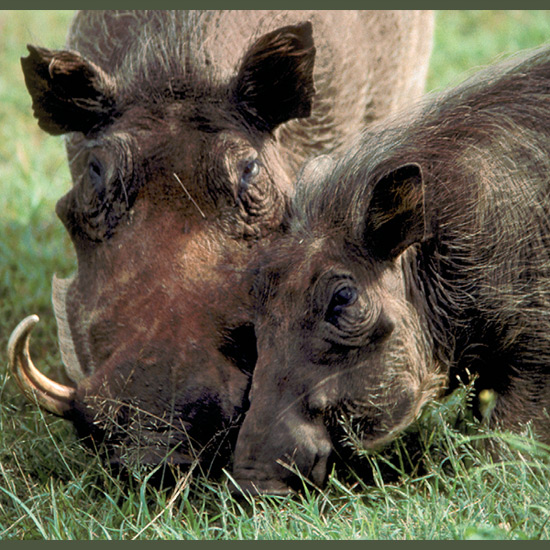Lake Malawi National Park
Notable is 34-square-mile (87-km2) Lake Malawi National Park and World Heritage Site, with million-year-old Lake Malawi and its extraordinary fish population—over 400 species of cichlids alone, ranging from an inch (2.5 cm) to almost two feet (0.5 m) long, many in dazzling tropical colors. Many have evolved into mouth brooders whose young are fertilized, incubated, hatched, and cared for in their mother’s mouth. More than 70 percent still are not fully described in their many and changing adaptations and species relationships. Visitors can observe them through snorkel and diving masks along underwater trails.
In shrubby grasslands and stony wooded hills around the lake, leopards stalk impala, gray duiker antelopes, and young spiral-horned greater kudus and bushbucks, occasionally vervet monkeys and young chacma baboons (chacmas are the largest primates in southern Africa). Stocky little klipspringer antelopes skip on tiptoes (or tip-hooves) along rocky outcrops. Hippos gather in pools, grazing on grassy edges.
Fish eagles dive along shorelines where Nile crocodiles bask. Several thousand white-breasted cormorants nest colonially on lake islands. Noted for rich birding are Cape Maclear and the shore and hills around Monkey Bay with Dickinson’s kestrels, freckled nightjars, swallow-tailed bee-eaters, trumpeter hornbills, yellow-fronted tinkerbirds, a variety of kingfishers, wading birds, and much more.
The park, 150 miles’ drive (250 km) east and south from Lilongwe, has trails for wildlife viewing, boats for hire, also equipment for diving and snorkeling.
There are hotels, guesthouses, and campsites nearby.
ALSO OF INTEREST
Nyika National Park, wild and open, protects the vast, beautiful Nyika Plateau in north Malawi, 1,210 square miles (3,134 km2) of flower-carpeted grassland, marsh, streams, waterfalls, and forested slopes on which grow some 200 orchid species. These lush habitats are home to almost 100 mammal species, including one of the densest leopard populations in Africa, also Burchell’s zebras, oribi, elands, blue duikers, roan, klipspringers. Among over 400 bird species are such rarities as wattled cranes, blue swallows, moustached green-tinkerbirds, Malawi batis, Denham’s bustards, exquisite scarlet-tufted malachite sunbirds.
There’s good park literature, access by air, comfortable accommodations, and many miles of wildlife-viewing tracks for walking, horseback-riding, or driving, including guided night drives, about 62 miles (100 km) west and north of Rumphi. At 385 square miles (1,000 km2), Vwaza Marsh Wildlife Reserve just to the south has rare babbling starlings and chestnut-backed just to the south has rare babbling starlings and chestnut-backed sparrow-weavers, also substantial large mammal populations.
Kasungu National Park, about 25 miles (38 km) west of Kasungu, may have on its 894 square miles (2,316 km2) of rolling miombo woodland and open, seasonally flooded flats more large mammal species than any place else in Malawi—buffalo, elephants, greater kudus, roans, hippos—and at the other end of the size scale, curious insectivorous four-toed elephant-shrews with noses like tiny trunks. Among birds are giant eagle owls, purple-crested turacos, swallow-tailed bee-eaters, yellow-billed hornbills, red-winged warblers, starred robins, brown-headed parrots, Miombo sunbirds. There’s a comfortable lodge overlooking water and a 175-mile (280-km) road network—best viewing toward the end of dry season August–November.
Lengwe National Park, 342 square miles (887 km2) in the Shire Valley south of Blantyre, has large nyala herds, suni antelopes, Burchell’s zebras, bushbucks, kudus, prolific birdlife including handsome bush-shrikes, barred long-tailed cuckoos, black-and-white flycatchers. Basic accommodations.
Liwonde National Park, 224 square miles (580 km2) along the Shire River 40 miles (64 km) north of Zomba, is noted for abundant elephants, one of the densest hippo populations in Africa, crocodiles everywhere along the river, waterbucks, kudus, warthogs, large herds of handsome sable antelopes, yellow (chacma) baboons, black rhinos, and more than 400 bird species including Pel’s fishing owls, pygmy-geese, open-billed storks, Lillian’s lovebirds. There’s a recentlyrenovated lodge with tented camp overlooking river and floodplain, also campsites. Access is by riverboat from Liwonde, a wonderful trip.
In the center of the capital is 370-acre (150-ha) Lilongwe Nature Sanctuary with over 200 bird species in its thick bush, gallery forest,and bamboo thickets, including white-backednight herons, African finfoots, African and black goshawks, white-faced scops owls, bluebreasted cordon-bleus, magpie mannikins, and amethyst sunbirds. Mammals include bushbucks,duikers, bushpigs, zebras, serval cats, leopards, hyenas, otters. Unfortunately this sanctuary has not been adequately maintained in recent years and at this writing, visitors are advised to avoid it, pending improvements.
A number of smaller Malawi reserves are excellent, especially Elephant Marsh, a 350-squaremile (910-km2) wetland paradise south of Blantyre, important for hippos, crocodiles, and more than 300 bird species.
Threats to all these include agricultural encroachment, pollution runoff, poaching, logging.
Climate divides into hot-dry September–November, hot-wet November–April, and cool-dry May–August. Best for wildlife-viewing is May–October. The capital, Lilongwe, is served by international air, with local air connections north and south, good bus connections in all directions, rental cars, and a good local road system. Or, take a beautiful lake cruise.
Note: As with all African countries, visitors need to be aware of and check for the possibility of bilharzia, or schistosomiasis, in shallow waters and reedbeds. The cure is a simple tablet, but the disease can be troublesome if not diagnosed.
Click on image for description.
Visit Tripadvisor®
for lodging information about this Reserve
LAKE MALAWI NATIONAL PARK as well as...
Nyika National Park
Vwaza Marsh Wildlife Reserve
Kasungu National Park
Lengwe National Park
Liwonde National Park
Lilongwe Nature Sanctuary
Elephant Marsh
Advertisement


